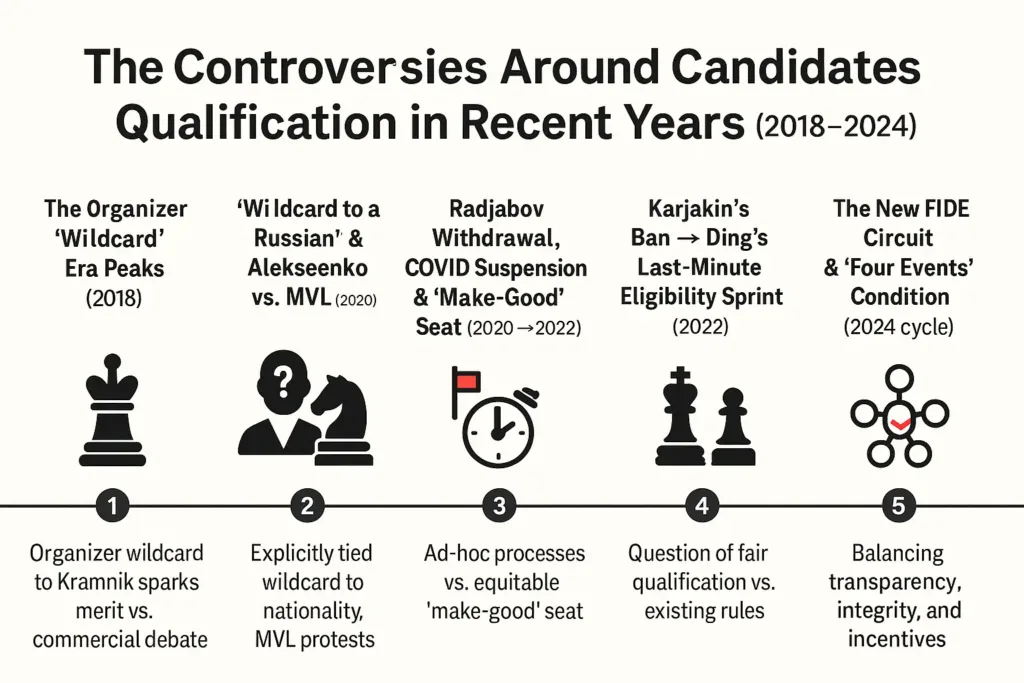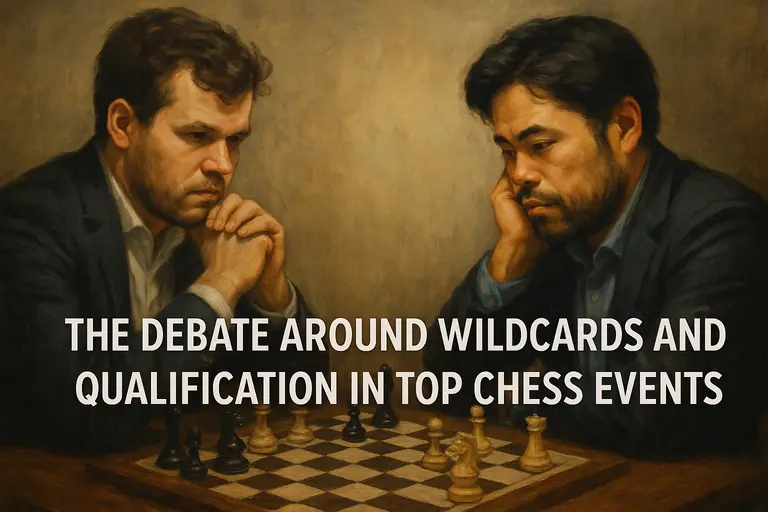The Candidates Tournament decides who plays for the world chess title, so every seat is precious—and sometimes disputed. Over the last few cycles, several qualification paths (wildcards, rating spots, replacement rules, and the new FIDE Circuit) have triggered arguments about fairness and transparency. Below is a clear timeline of the biggest flashpoints, what the rules said, what actually happened, why it was controversial, and how each episode ended.
- 1) The Organizer “Wildcard” Era Peaks (2018)
- 2) “Wildcard to a Russian” & Alekseenko vs. MVL (2020)
- 3) Radjabov’s Withdrawal, COVID Suspension & “Make-Good” Seat (2020 → 2022)
- 4) Karjakin’s Ban → Ding’s Last-Minute Eligibility Sprint (2022)
- 5) The New FIDE Circuit & “Four Events” Condition (2024)
- 6) Firouzja’s “Race to Candidates” in Chartres (2024)
- 7) Hikaru Nakamura “Farming Minnows” at State Championships (2026)
1) The Organizer “Wildcard” Era Peaks (2018)
What happened. In 2018 the organizer (Agon/World Chess) could nominate one player—the “wildcard.” They chose former world champion Vladimir Kramnik, who hadn’t otherwise qualified. Many welcomed the star power; others argued a free seat distorted a merit-based field.
Why it mattered. The pick highlighted the tension between sporting merit and commercial considerations. The debate helped fuel later calls to abolish wildcards entirely.
Outcome. Kramnik played Berlin 2018; the wildcard rule would return (controversially) in 2020 before being scrapped for 2022.
2) “Wildcard to a Russian” & Alekseenko vs. MVL (2020)
What happened. For Yekaterinburg 2020, the host federation publicly signaled the wildcard would go to a Russian player and later confirmed Kirill Alekseenko. Maxime Vachier-Lagrave (MVL) even published an open letter arguing he deserved the spot on sporting grounds. Fans also noted rising star Alireza Firouzja would miss out.
Why it mattered. Explicitly tying the wildcard to nationality struck many as unfair, and the whole episode revived criticism that wildcards shouldn’t exist at all (Alekseenko himself later agreed in interviews).
Outcome. Alekseenko kept the seat; the backlash strengthened momentum to remove wildcards from future cycles.
3) Radjabov’s Withdrawal, COVID Suspension & “Make-Good” Seat (2020 → 2022)
What happened. Days before the 2020 event, Teimour Radjabov withdrew over COVID-19 concerns after FIDE declined to postpone; MVL replaced him per regulations. Mid-tournament, global travel restrictions forced FIDE to suspend play after Round 7—exactly the disruption Radjabov had feared. He hinted at legal action. In June 2021, FIDE granted Radjabov a direct spot in the 2022 Candidates as compensation.
Why it mattered. Critics felt processes were ad-hoc; supporters thought the “make-good” seat was equitable given the unprecedented suspension.
Outcome. Radjabov played the 2022 Candidates; by then, the wildcard and simple rating spot were removed from the qualification mix.

4) Karjakin’s Ban → Ding’s Last-Minute Eligibility Sprint (2022)
What happened. After public comments supporting Russia’s invasion of Ukraine, Sergey Karjakin received a 6-month FIDE ban, ruling him out of Madrid 2022. Under the rules, the replacement was the highest-rated eligible player. Ding Liren had the rating but lacked the minimum 30 classical games in the qualifying period due to China’s pandemic restrictions—so he played an extraordinary flurry of domestic classical games in April 2022 to cross the threshold. FIDE then confirmed Ding as Karjakin’s replacement.
Why it mattered. Many questioned whether arranging a block of rating-eligible events on short notice (perfectly within the rules) met the spirit of fair qualification; others argued the rule existed precisely to handle such edge cases.
Outcome. Ding entered—and ultimately won the 2023 World Championship match the following year. The episode spurred calls to tighten eligibility criteria and reduce loopholes.
5) The New FIDE Circuit & “Four Events” Condition (2024)
What happened. For the 2024 Candidates, FIDE replaced the old rating spot with a new FIDE Circuit (one seat for the year’s best cumulative classical results) and added a “minimum four eligible tournaments” requirement tied to rating qualifications/eligibility. Gukesh Dommaraju won the 2023 Circuit and qualified, while several top players publicly criticized the Circuit’s complexity and mid-cycle clarifications, arguing the system was confusing and could influence event selection.
Why it mattered. The Circuit aimed to reward activity and performance across the calendar, but players worried about moving goalposts and whether all qualifying events were comparable.
Outcome. The 2024 Candidates field was set under the new framework; debate continues over how to balance transparency, competitive integrity, and incentives to play more classical chess.
6) Firouzja’s “Race to Candidates” in Chartres (2024)
What happened. Under the 2024 rules, the highest-rated player in the January 2024 list not yet qualified (with at least four eligible classical events played) would take the rating spot. After a poor Sinquefield Cup, front-runner Alireza Firouzja fell behind Wesley So in live ratings. To recover, his Chartres Chess Club staged three short matches in December 2023 against lower-rated veterans (Dgebuadze, Shchekachev, and Fedorchuk). Firouzja needed near-perfect scores to regain the edge. He won 5½/6, but this still left him just short of So.
Why it mattered. The hand-picked opponents and last-minute organization drew accusations of gaming the system. Wesley So criticized the ethics of such events, while FIDE hinted it could refuse to rate them. Critics also noted similarities to Ding’s 2022 sprint, raising questions about consistency.
Outcome. On December 25, 2023, FIDE introduced a new rule requiring events with 2700+ players to be registered at least a month in advance (though not retroactively applied to Chartres). In the end, Firouzja entered the Open de Rouen, scored a perfect 7/7 (including a win over former challenger Gata Kamsky), and gained enough rating points there to finish ahead of So on the official January 2024 list. FIDE confirmed Firouzja as the rating qualifier.
7) Hikaru Nakamura “Farming Minnows” at State Championships (2026)
What happened. In September 2025, U.S. superstar Hikaru Nakamura surprised the chess world by entering modest state-level tournaments such as the Louisiana State Championship and the 70th Iowa Open. These events normally attract local experts, masters, and ambitious juniors rated 1800–2200, but suddenly had to seed in a 2800+ super-grandmaster. Nakamura swept Louisiana 6/6 and Iowa 5/5 as the overwhelming favorite, facing opponents sometimes over 600–1,000 Elo points below him.
Why it mattered. Nakamura’s appearance wasn’t about prize money (top prizes were just a few hundred dollars). Instead, it was widely interpreted as an effort to accumulate enough classical games to stay eligible for the 2026 Candidates rating spot, which requires 40 rated classical games within the qualifying window. Having played relatively few elite tournaments earlier in the year, Nakamura needed every extra game he could find. State opens offered a relatively low-risk environment to add games without facing peers who could dent his rating.
This sparked heated debate. Supporters argued that Nakamura was simply following the rules and giving local players a once-in-a-lifetime chance to face a legend. Critics, however, called it “rating farming”—exploiting mismatches against weaker players to secure games (and avoid rating danger) in pursuit of Candidates eligibility. Even popular commentators like IM Levy Rozman described the situation as a systemic flaw in FIDE’s rules, not a moral failing of Nakamura himself.
Outcome. For Louisiana and Iowa players, the events were unforgettable. Amateurs and juniors lined up for autographs, and hotels proudly advertised Nakamura’s presence. Locals spoke of the tournaments as historic moments in their state’s chess life. But on the international stage, the controversy highlighted yet again how qualification requirements (especially minimum game thresholds) can incentivize elite players to enter competitions far below their level.
Bigger picture. Like Ding Liren’s last-minute sprint in 2022 and Firouzja’s “Race to Candidates” in 2023, Nakamura’s state-championship appearances underscore how qualification rules can produce unintended incentives. Instead of rewarding participation in elite tournaments, the system sometimes nudges top players toward strategically chosen low-stakes events. Whether this enriches grassroots chess or distorts the competitive spirit remains an open question—but either way, Louisiana and Iowa 2025 will be remembered as the year local club players suddenly found themselves across the board from one of the world’s very best.

I’m Xuan Binh, the founder of Attacking Chess, and the Deputy Head of Communications at the Vietnam Chess Federation (VCF). My chess.com and lichess rating is above 2300. Send me a challenge or message via Lichess. Follow me on Twitter (X) or Facebook.

